Sankuro 2020: Lessons for a Parent of a Sixth-Grader
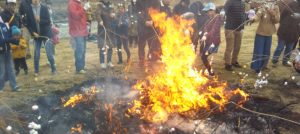
This past weekend Matsumoto saw the 2020 edition of Sankuro, the yearly tradition of burning last year’s good luck trinkets in spectacular family-friendly fashion. The general run-down of all the smoke-filled, eye-burning fun can be found in a post I wrote last year on the subject. But this year I return to the tradition armed with some new and, unless you are going to have a sixth-grader in the Japanese school system someday, entirely useless information.
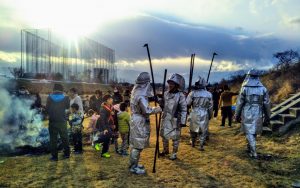
At least in my neighborhood, all the parents of the local school’s sixth-graders are responsible for pitching in and carrying out a riverside event worthy of quietly-sociable Japanese people with underlying pyromaniac tendencies. My oldest son is in sixth grade, so there I was, up close and intimate with all the intricacies of building a bonfire that I hoped would not send any of the hundred kids in uncontrolled attendance to the hospital. Here’s what I learned. I hope you never need it.
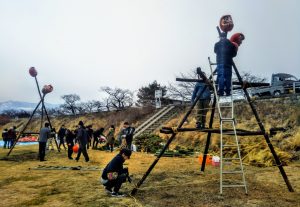
#1 – Use rope, not wire.
The simple, pyramidal frame of the Sankuro pyre requires a delicate balance of sturdy and collapsible. The pine branches and bundles of straw they will hold don’t weigh too much, but the father who loses in rock paper scissors has to climb the thing to tie rope and skewer a few daruma dolls to the top. So he wouldn’t be the first in an ambulance we lashed the posts of the frame together with metal wire. This, however, would make the pyre too sturdy, for reasons we’ll see in a moment.

#2 – Money is not an issue.
The fundamental idea behind Sankuro is the burning of used-up items of good luck. And by used-up I don’t mean old and worn out. In Japan, whatever good luck comes with your daruma dolls and lucky charms is only good for a year. Honestly, I don’t know if the idea comes from the annals of ancient Japanese tradition or the vision statement of JALT, the Japan Association of Lucky Trinkets. Either way you end up with people burning without any questions asked perfectly good (at least on the outside) daruma dolls and other such decorations, including the elaborate New Year’s front door adornments called kadomatsu, which in some cases go for two or three hundred bucks.
I’d take a few of these kadomatsu home and put them outside my front door but my wife, being Japanese, would then feel compelled to call in an exorcist. So these things burn. And JALT members across the land rejoice.
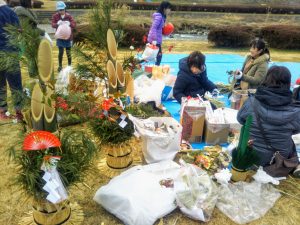
#3 – Keep it clean.
As people from the neighborhood come by to drop off their daruma dolls and pine branch new year’s decorations the moms of the sixth-graders, along with some of the more helpful sixth-grade girls, will go through and separate out the unburnable bits like aluminum wire and plastic zip-ties. The boys, meanwhile, gleefully take on the task of punching holes in the tops and bottoms of the daruma dolls so they can be strung up.
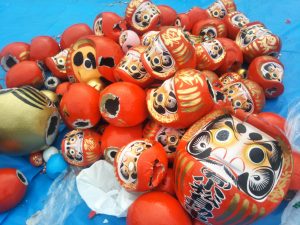
#4 – Presentation is key.
A pile of dried straw and drier pine branches is going to go up in flames no matter how you stack them. (I’ve seen people smoking at gas stations in Japan, but lighting up anywhere near the grounds of a developing Sankuro seems to be a definite no-no.) But just as that piece of broccoli in the bento my wife makes for my kid has to sit just right, the elements of the Sankuro pyre all have their proper places. Bundles of straw on the bottom two thirds. Pine branches on the top half. Daruma dolls strung up like tinsel on a Christmas tree. And pieces of bamboo placed vertically all around the foot of the inferno-to-be.
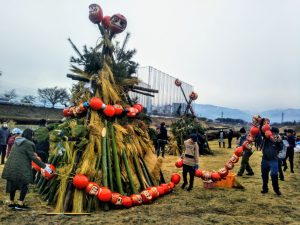
To keep the sixth graders from pretending their torches are light sabers and javelins they are tasked with hammering holes in the bamboo to let air in so they burn more quickly, hastening the mochi-roasting part of the afternoon.
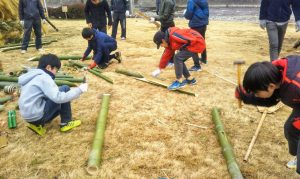
#5 – Out with the old (socks).
I admit to being a bit concerned when I found my son making a torch the other day, with a length of bamboo and a couple of old socks. I knew he’d been a bit stressed as of late, studying for his middle school entrance exams and all, but had it really come to this? I was no less intrigued when he told me that all his classmates were making them too. Imagine my relief, then, when he told me they were for the lighting of the pyre.
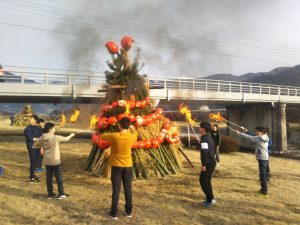
I told him if he wanted to make an even bigger torch I had a few old and holey socks in my drawer he could have.
#6 – Back to the wire.
Once the boys put their torches to the pyre it’s only a minute before the entire thing is engulfed in flames and thick swirls of smoke. At this point the firemen start yelling at everyone to get back – as if the sudden, intense heat hasn’t already sent a few of the kids diving into the nearby river. Then one or two of them attack the fire with long hooks and pull on the frame until it collapses.
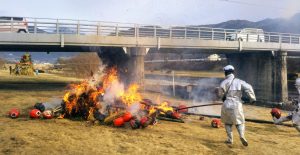
This is why we had to unwind and remove all the wire we’d initially used to hold the frame together. Wire doesn’t burn nearly as quickly as rope, and our neighborhood firefighters were not quite as interested as the kids were in letting the fire get as big as possible to see if the flames would reach the cars passing over the bridge.
So down comes the pyre, and with that the kids move in to start roasting their mayudama as best they can without going permanently blind from the smoke that is still swirling.
#7 – Carry a long stick.
These mayudama the kids are roasting are made from a water and rice powder mixture that has all the texture and, fortunately, less taste than Play-doh, They fashion this rice clay into all sorts of shapes and stick them on plum tree branches so thin they droop under the weight, making it even tougher for the kids (and, after eleven seconds, the parents) to hold them far enough out over the smoldering pyre without one’s skin catching fire.
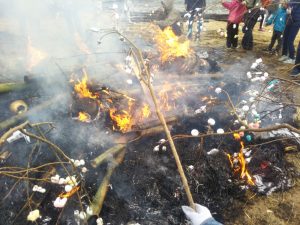
The easy remedy would be to use longer branches. Maybe when my second kid is in sixth grade I’ll say something.
#8 – Leave nothing but fire prints.
The fires of Sankuro go out almost as fast as they went up, and soon there’s nothing to do but go home and floss. But for the sixth-graders and their parents it’s clean-up time. Even the firemen have gone home as the moms (and, oddly, few of the dads) begin pouring water over the dying embers. But not too much water as the soggy remnants have to be shoveled into thick plastic bags and hauled away. Meanwhile the two dads that have stuck around, with the help of the remaining sixth-grade boys, salvage the pieces of the pyre’s frame for use again next year – one more reason to use rope instead of wire to pull them down before the bridge goes up in flames.
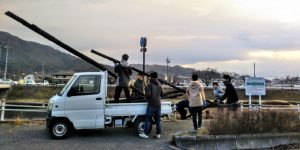
And as everyone clears out there is nothing left of last year’s luck but huge patches of burned grass, all up and down the rivers of Matsumoto.
But that’s okay. Those scars in the ground will be gone soon enough. Unlike the mayudama my kids didn’t finish. They’ll remain for months in the back of the fridge, rock-hard and forgotten.